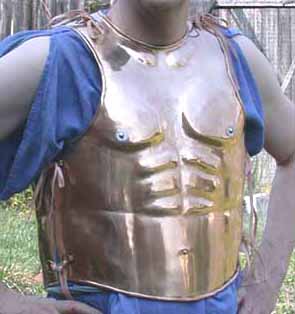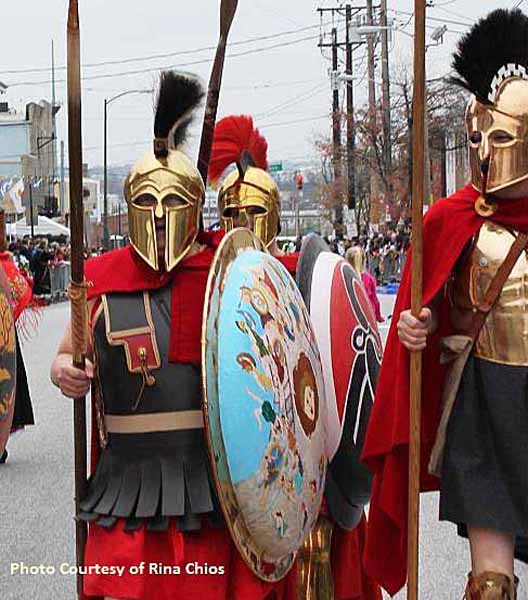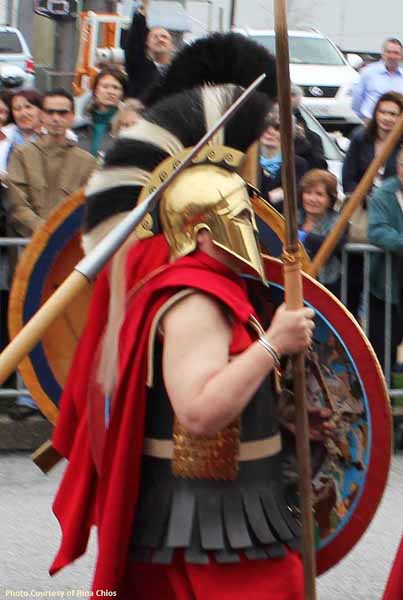| Hoplite Home Page |
Clothing | Helmets | Photos | Other Greeks,
and Others |
| Shield--Aspis/Hoplon | Armor | Weapons |
Bibliography | The BRONZE AGE |
THORAX--Bronze Cuirass
 |
The
Greek word for body armor in general was "thorax", a
term which covers several different styles.
Probably the best-known is the muscled cuirass, a bronze
corselet embossed with a stylized depiction of a man's
musculature. The decoration varied
considerably over time, but was generally not as extreme
as on many modern reconstructions. It also did not
line up with the wearer's anatomy, since the bottom edge
of the cuirass was roughly at the man's navel or lower
ribs, allowing him to bend freely. The upper chest
was also quite narrow to allow free movement of the
arms. Modern replicas are often too long and too
wide, restricting movement as well as adding unnecessary
weight. Original cuirasses were surprisingly light, as little as six pounds, as the metal could be less than a milimeter thick. The maximum weight was probably around 12 pounds. Note that many modern authorities grossly overestimate these weights! They are also too ready to dismiss these cuirasses as "ceremonial", but recent tests have shown that 1mm bronze sheet is highly resistant to the weapons of the time--this was fully functional and very protective armor. There is NO evidence that the muscled cuirass was ever made of leather! At least one Hellenistic example in iron has survived, however. The muscled cuirass was just coming into use at the end of the Archaic era, around the time of the Persian Wars. It was probably never the most common type of armor, being the "high end" choice. |
| I am
still gathering data on the use and appearance of
pteruges (flaps) below the waist of a muscled
cuirass. Pteruges are rarely with the bell cuirass
of the Archaic era, and are far from common with the
Classical muscled cuirass. They are more common in
the Hellenistic era. When they do appear, they are
generally all the same length (not longer in the front),
and there are no studs or other "reinforcements" besides
an edging of some sort. The popular belt of studded black flaps should be avoided! It's pure Hollywood, I'm afraid. If you already have one, just stop wearing it and you will look MUCH more authentic. It may have a very nice ROMAN buckle which you could sell or trade to greedy legionary. The brass bits might be usable for some other project. |
A quick Google Image search on "Greek Muscle Cuirass" will show you a few nice originals, plus MANY reproductions. Comparing old to new will give you an idea of the accuracy of those available commercially.
In the Archaic era, up through the Persian Wars, the common bronze armor was the bell cuirass. This was the ancestor of the muscled cuirass, and somewhat simpler in form. Embossed curled lines define the pectorals, while the stomach muscles are denoted by inverted U- or V-shapes. The bottom edge tends to flair out a little, or has a distinct flange, though a few original cuirasses are quite straight and tube-shaped. Sometimes there was a semi-circular plate (possibly known as the "mitra") hanging from the bottom edge to protect the belly, but this may be a very Cretan feature.
 |
Kevin Hendryx's bell cuirass and helmet, made by Darkheart Armory. |
Finding a decent cuirass "off the shelf" can be tricky. Deepeeka and other Asian manufacturers offer a wide variety of armor through vendors such as By The Sword ( http://www.bytheswordinc.com/ ) and Kult of Athena ( http://www.kultofathena.com ). Unfortunately, much of it, historically speaking, is junk, and of course it typically comes in only one size so it is not likely to fit you well. But here are some suggestions for what looks to me like the better choices. For starters, stick with BRASS or BRONZE, not steel or leather!
Royal Oak Armory--Jeffrey Hildebrandt. http://www.royaloakarmoury.com/ THE BEST.
Manning Imperial--Craig Stitch, Australia. Bell cuirass or muscled cuirass, really good stuff. http://www.manningimperial.com/catalogue/armour/greek-and-roman-body-armour/35
Deepeeka AH6071B Brass Muscle Cuirass --Probably a little big on many folks, and too long and wide across the chest in any case. The muscling is not really historical, and the nipples are misplaced. Easiest improvement is to cut off the flange around the bottom edge! File or roll the cut edge.
--I do not recommend their AH6096B Bell Cuirass, not a good shape, too wide and long. AH3876 Short Muscle Cuirass is plated steel, and shoulder flaps are more Roman than Greek. AH3875 Muscle Cuirass is at least brass, but still has shoulder flaps (might be removable?). Obviously don't buy any of their black or leather armor!
Kult of Athena Brass Muscle Cuirass - IR80513 --Looks like a copy of the Deepeeka cuirass. Remove the big straps and buckles and replace with rings, and of course chop off the bottom flange.
Deepeeka Brass Muscle Cuirass AH3875--Better overall than AH6071, except that the shoulder flaps are really a Roman feature, or at least Hellenistic. Maybe they could be removed?
Armae Greek Bell Armor AC129--Reasonable-looking bell cuirass, might be wide across the armholes? (Much nicer than the Deepeeka version.) http://www.armae.com/Zenglish/greek_and_roman/antiquity_frame.htm (AC125 seems to be Deepeeka AH3876)
SPOLAS--Leather Tube-and-Yoke Cuirass
Keeping in mind that vase paintings and other artwork are not a reliable indication of color, the funeral stele of Aristion shows a tube and yoke cuirass which is yellow, which may indicate a buff leather. Frescoes from Italy, all from the 4th century or later, show white, pink, and other colors. White may indicate the use of alum-tawed leather, which is white, and which was apparently produced in great quantities in Athens. We actually know little or nothing about the type of leather used, nor the thickness, nor how many layers there were, so we can not draw many firm conclusions about the weight or protective qualities. The popularity of this armor strongly implies that it was effective enough for the men who wore it, though if it was anything as protective as a bronze cuirass it must have been significantly heavier. The fact that it is often depicted as very ornately decorated, and worn by heroes and gods, also implies that it was not necessarily seen as "cheap" armor--we can only assume that it was less expensive than a bronze cuirass.
Getting a good feel for the appearance of the spolas is not difficult, just look at the pictures! You can find quite a few vase paintings and other Greek artwork with some Google searching. As with any reenactment gear, avoid the urge to add embellishments that can't be seen in original artwork or archeological examples. Remember that modern artwork and reconstructions done by other people are not historical evidence! They can certainly be inspirational, but don't copy them unless you can see that what they did is something the Greeks actually did (or at least depicted!). There is obviously some leeway as far as painting or dyeing the leather, and for some details of shaping. But if you stick to what we know from the evidence, you won't go far wrong.






